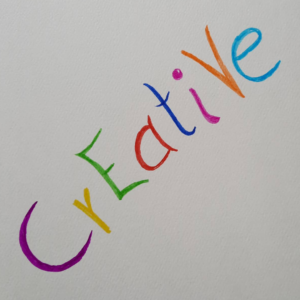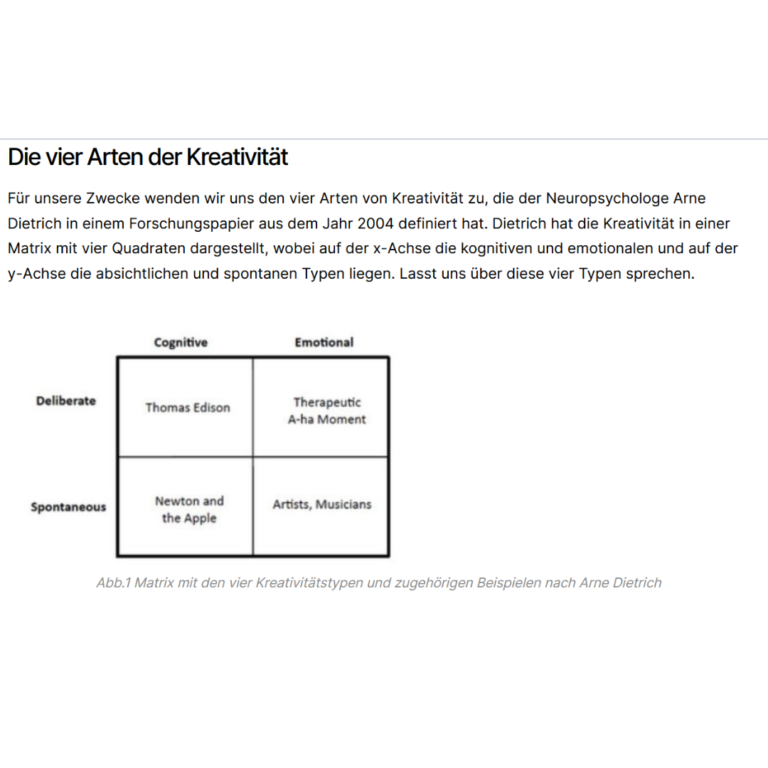
“What is creativity for you? Or creative?”, I ask my children. Brainstorming with family support, so to speak. Honestly, that’s where I write about creative TECHNIQUES, have been a role-player for years (certainly not uncreative) and both make up the bulk of my coaching work. So! Reason enough to get to the bottom of the matter, er the word, a bit more, I thought and had in mind to find out a bit more about the term “creativity” and to report about it. My motto was to approach the whole thing a bit more professionally, not just write about it. But is that even possible?
A little brainstorming
“Creative is letting your imagination run wild… , and then…. paint colorful mountains. Or purple trees.”
That was the personal brainstorming result of the children. And I have to admit, that’s kind of my association when I let my mind wander to that. But is there more to it than that? Is this just the common interpretation? Has anyone ever looked into this in more detail? And can creativity be learned?
“Oh yes!”, as I was allowed to find out! Totally exciting! So here comes a little bit more theory about creativity!
And no, it is not true that you are either creative or not! That creativity is genetically determined, so to speak. That would be a bit too simple. So the good news is: sure, you can learn it!!! Of course YOU can learn it! It’s even fun, especially when I get into the game (into the game in the truest sense of the word ;)).
But from the beginning!
So I started brainstorming and thought about what I personally imagine creativity to be. And that is probably also what the majority of mankind imagines by it, if you would ask them.
“Creatives” are painters, poets, musicians…., in summary, artists or even geniuses! The unattainable.” They ARE creative by nature, creativity was literally born into them, inherited or whatever. They create ideas in their own minds, on the spiritual, subtle level, so to speak, and then receive them on the gross level, on the outside, produce them, put them on paper (song, image, text whatever). A bit too spiritual? Well, what this stroke of man certainly actually has in common is a more or less pronounced access to one’s own spirituality (or whatever you want to call it). The access to the great depths of one’s own consciousness. It is produced in the head, followed by intuition, the mind is seemingly emptied of automated rational thoughts.
And this association is not so wrong and describes quite exactly one of FOUR “kinds of creativity”. Namely the so-called “spontaneous, emotional creativity”. So there is even a technical term for it.
A bit of theory
Because yes, someone has actually dealt professionally, let’s call it scientifically, with the topic! Super exciting, as I find. Meaning, so there are three more “types” of creativity And there is also a scheme! For those of you who love such classifications 😉
In 2004, a certain Arne Dietrich published on the topic of creativity from the perspective of brain and neuroscience. He defined four types of creativity that originate in different brain regions and assigned them to corresponding brain activities. Not bad. Here comes the scheme and what’s behind it:

1) Volitional and cognitive creativity.
2) Volitional and emotional creativity.
This type of creativity contains parts of type 1, but arrives at its findings by pondering and asking questions, not by experimenting, i.e. silently thinking about a situation by oneself. A foundation of knowledge is not necessary. Often a so-called “aha moment” occurs, a realization, an idea that seems to come out of nowhere. However, it is rather the case that the brain arrives at answers because a multitude of thoughts have already been “rolled around” in advance and processed accordingly. To help people whose creativity falls on this scale, it is important to give them time to think and rest.
3) Spontaneous and cognitive creativity
In this type of creativity, there is no conscious engagement with a problem. It is the subconscious part of the brain working. The idea behind it is that a person’s brain is working on solving their problem while doing some other unrelated activity. An example of this type of creative thinking is how Isaac Newton thought about gravity while watching an apple fall. The cognitive part of this type of creativity forms the presupposed educational framework. Someone who falls into this category needs breaks to do something else thematically so their subconscious can continue working on the problem.
4) Spontaneous and emotional creativity.
Artists and musicians are assigned to this type of creativity. Consciously working brain areas and specific knowledge bases are switched off, leaving room for spontaneous creativity. People who experience this type of creativity describe it as very powerful or even enlightening. Certain skills of the artistic, literary or musical kind are assumed – specific prior knowledge on the cognitive level does not play a role. This is the only kind of creativity that one either “has or does not have.” It is probably unique and individually different.
Bis auf die spontane und emotionale Kreativität können alle anderen von jeder Person genutzt werden.
What all four types probably have in common:
Resources are needed for creativity, any creativity, to flow. Space, for example, and time and joy or passion. Resources that give the mind the opportunity to become louder than the external influences, than the sprinkling, the external input! How each one creates this space is left open, is individual. Space and time do not necessarily mean that you have to sit at your desk in silence and wait for good thoughts or the flash of inspiration. A lot happens, for example, in movement, in connection and in exchange with others. And depending on which of the four types applies to you, also through practice, practice, more practice and consequently expertise.And who would have thought it, but the personality development thing of course plays into it again. For example, rethinking common beliefs/convictions is not wrong on the way to your creativity. An example of such a belief would be: “Creativity has only something to do with fun and free time, so it is at most a hobby (for which I have no time anyway) and the people who are professionally creative have never really worked anyway…”. .”
Counterexample?
And now comes my counterexample: While I’m mentally writing this article, doing something for my work, so to speak, it’s half past eight on a Sunday morning and I’m walking through the cold winter air to a meeting with friends. Suddenly a thought pops up: One that should be included in the article. At which place it fits presumably best, presents me my head also still immediately with (is that now actually type 2 ?).
Conclusion
Finally, the realization remains for me that I actually really like this subdivision of creativity! So creativity is not an unattainable state. I knew it! Everybody can be and become creative in his own way, if he only allows the connection to himself again and at least a little bit. And that I can help you with my work, that is of course also very cool.
What kind of “creative” do you belong to? Usually one or two types apply to you.
Just see what comes spontaneously. That’s right and yes, it can be fun.
And second question: Has your creativity been lost and do you not quite know how to dig it out again? Then let’s see if I can help you. What do you think?
